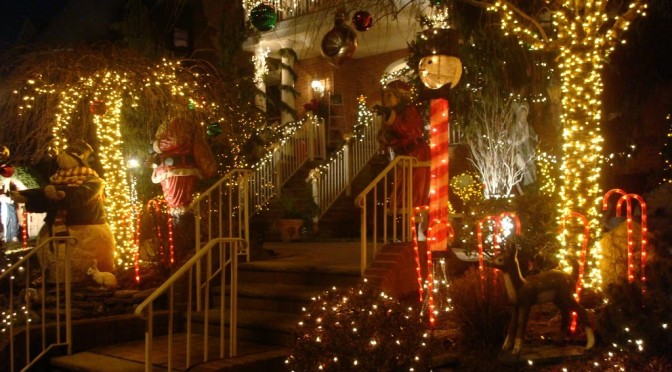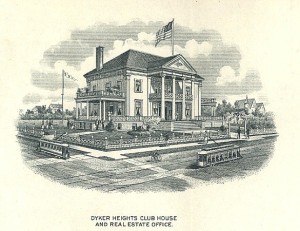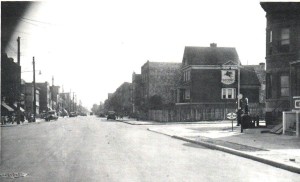Holiday traditions in Manhattan are of course known the world over, from the lights of Park Avenue to the Rockefeller Center Christmas tree. But they lack that human touch, spun from wealthy corporations and honored tradition. Which is what makes Dyker Height’s annual lighting spectacular (festival? competition? freakshow?) so fascinating. It’s Brooklyn’s biggest holiday event, run entirely by the community.
The extravaganza has energized a neighborhood few in New York know much about. For most of its history, Dyker Heights was virtually uninhabited, either by humans or two-story illuminated snowmen.
Dyker Heights is named for an uninteruppted, sloping meadow which rolled down to the waters edge (today interuppted by the rushing traffic of Shore Parkway). Nobody’s certain where Dyker Meadow got its name, only that it originated from the days of Dutch occupation, either from a Van Dyke family which settled here, or, more generally, from actual dykes the family built to drain the meadow.
Tumuluous history springs up on either side of Dyker meadow and its small forests, as the British who land at nearby Denyce Wharf begin their invasion of Brooklyn in 1776, taking up battle with the Continental Army to the north and east. As part of the township of New Utrecht, the meadow was unsuitable for farming, but its forests were plenty suitable for firewood and materials for building homes.
Development finally came to the area shortly before Brooklyn consolidated with New York. During the 1890s, the nearby area of Bath Beach was quickly becoming a resort getaway similar to Coney Island. Called Bensonhurst-by-the-Sea, the resort adhered to strict moral entertainments (i.e. no booze) and thus was destined to fail. Luckily, by then, an elevated West End train line (the Brooklyn, Bath and Coney Island line, back in the day) was attracting speculators eager to draw New Yorkers with residences built on old farmlands. By 1911, the New York Times excitedly noted the saavy practices of land developers in this region of South Brooklyn.
The father of Dyker Heights is developer Walter L. Johnson, who in the 1890s scooped up the land, brought roads and utilities to this fairly remote part of Brooklyn, and quickly created a small community. He even named the area, the ‘Heights’ assumably tacked on to embue it was a cache similar to Brooklyn Heights. Johnson’s gamble paid off; in 1899, the Wall Street Journal proclaimed, “nowhere else in the consolidated city is there anything to compare it with. From here can be seen a marine panorama hard to beat.”
Below: the Dyker Heights Club House, built in 1898
Today Dyker Heights is a predominantly middle- to upper-middle class Italian neighborhood, anchored by the Dyker Heights golf course and sandwiched between Bay Ridge and Bensonhurst, with old Fort Hamilton to the southwest and what remains of the old Bath Beach resort area just southeast of here.
What Johnson could not have predicted — heck, what Thomas Edison, inventor of electric light bulb, could not have foreseen — is the annual holiday expression that occurs on the lawns of many Dyker Heights residences through December.
Below: 13th Avenue in Dyker Heights, 1934 (Pic courtesy Dyker Heights community website)
The neighborhood is already known for its unique, ornamented homes, front lawns festooned with fountains, animal statuary, ornate shrubbery, perfectly manicured grass and home waterfalls. For the holidays, the busy lawns are then burdened with an abundance of lighted sculptures, animatronic dioramas, illuminated trees, and every manner of festive lawn display imaginable. (You’re more likely to see a holiday-themed Mickey Mouse than a Santa Claus.) Imagine an eight-year-old child given a million dollars and a mandate for holiday landscaping.
Befitting an organic neighborhood celebration, the origins of this annual tradition are a bit hazy. Families began hosting displays as far back as the post-war years of the 1940s. An article from the New York Times last year suggests that the neighborhood’s Italian leanings may have something to do with it.
The show is concentrated on 84th Street between 10th and 13th Avenues but it easily spills over to other blocks and even into the borders of adjoining neighborhoods. I used to prefer seeing it from the luxury of an automobile, given the cold, but this year I went a bit early (some displays go on as soon as the sun sets) and hoofed it. It’s only a few blocks from a subway, and you get to interact with the various Santas and Elmos. With a good stroll, you can also soak in the Christmas music that seems to emanate from every home.
By the way, much of the history of Dyker Heights was unearthed a few years ago in a thesis paper by then student Christian Zaino. A model example of a budding New York historian, his research was so exhaustive that one of Dyker Heights’ more glamorous homes — the Saitta House — entered the National Register of Historic Places on the strength of his research. In fact, this is probably one of the few instances that you can use Wikipedia for a resource, as Zaino wrote the page.









1 reply on “Blinded by the lights of Dyker Heights”
I love watching kids approach the massive Santa. Human sized Santas are worth crying about, but that one…it’s as if the kids go to a place beyond tears they are so overwhelmed.